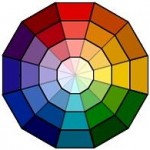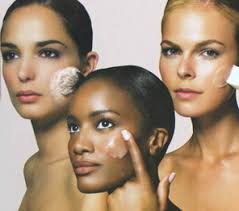Shiny and frosted cosmetics have a similar affect to light coloured make-up. They enhance or bring out the area on which they are applied. To maximize this effect, combine the two qualities – light and shine. Light make-up colours that are frosted or shiny will make an area appear even more pronounced. The facial feature where it is applied will appear larger and visually push out more than when applying a light matte cosmetic colour. This maximum effect will also cause the area around it to appear flat or sunken in comparison. This can work wonders to enhance the lips, cheek bones, eye lids or brow bones.
Tag Archives: look younger make-up
Use Colour to Harmonize or Dramatize
When applying make-up, colour can be combined in various ways to create different results. Color can create a harmonizing effect by enhancing an individual’s natural colouring. It can also create drama.
- Similar colours harmonize
- Contrasting colours next to each other emphasize one another and add dramatize
- Applying a colour on top of its complementary colour (opposite colours on the colour wheel) will neutralize both colours.
- Light and dark colour worn side by side will dramatize the facial features making them appear more pronounced.
Highlight Your Facial Features
Make-up application relates to the actual structure of the head and face.
The natural hills and valleys of the face can be recreated or enhanced with optical illusions created by using light and dark cosmetics.
Highlighting is the application of a make-up colour that is lighter than the surrounding area. This area will appear more pronounced than the area next to it.
How to Choose a Make-up Brush
There are a variety of make-up brushes that range in size and shape. The lip brush is generally one of the smallest and the powder brush is generally the largest. There are many more kinds of brushes of different sizes in between.
The most important thing to consider is making sure the brush you use is suited for the job. The best way to pick the right brush is to choose one that is a reasonable size and stiffness – for the make-up product, desired effect and area the product is to be applied.
- A stiff brush will deposit more colour and works well for a dramatic effect or precise application.
- A wide brush works well for applying colour to large areas and for blending.
- An angled or dome shaped brush works well for contouring or shading.
- A small to medium brush, angled or dome shaped of medium stiffness, works well for precise work such as shading small areas.
Choosing Between Warm and Cool Make-up Colours?
Approaching the make-up counter can be confusing with the wide array of colours to choose from. Make-up colours that are in the same undertone as your skin, eye and hair colour will make you look healthy and beautiful.
If your features are naturally warm you will notice ivory, yellow, peach or golden tones in the skin. The hair will likely have yellow, golden or orange undertones. The colours in the eyes will have some or all warm colours.
- Examples of warm colours – peach, golden yellow, camel, rust, russet, gold, olive, golden brown, sea green, bronze, spices, etc.
If your features are naturally cool you will notice porcelain, pinks, rose, blues, violet or olive tones in the skin. The hair will likely have ash, taupe, coco, or black tones. The colours in the eyes will have some or all cool colours.
- Examples of cool colours – coco brown, taupe, black, pink, rose, true blue, burgundy, berry colours, black, etc.
With some of us it’s difficult to tell if our colouring is warm or cool. Some of us have both warm and cool colouring. If this is the case, you have more options. Experimenting is the easiest way to find what works. If still in doubt, I would recommend a professional colour consultation with an image or colour consultant.
Choosing Your Colours
The easiest way to achieve natural looking results is to choose your make-up in light tints, dark shades, and muted tones rather than clear, bright hues. The more muted the colour, the more neutral it becomes.
- Neutral colours are the most versatile and work well with most skin tones and eye colours unless you are very fair or very dark. e.g. browns, black, greys, tints (off whites), etc.

- For more drama, when working with eyes, choose a tone from the colours opposite your eye colour on the colour wheel. e.g. Blue eyes – coral, peach, pink and yellow tones.
Why Wear Matte Make-up
Matte cosmetics appear flat on the skin. A dark matte product will absorb more light than a dark frosted colour, making the area appear more receded. A matte light colour will appear flat on the skin compared to a shiny, light colour.
Use medium to deep make-up colours with a matte finish on facial areas that you which to look pushed back. This application applied under the cheek bones, in the crease above the eye lid and other areas will add definition to your facial features.
The Art of Contouring
Facial contouring is a technique used by make-up artists to optically exaggerate or change the natural features of the face. By mastering contouring techniques you too can achieve expert results.
When applying make-up the term shading refers to the application of a colour that is darker than the surrounding area. This will contour or enhance the natural hills and valleys of the facial structure or can create the illusion of new contours. The darker colour enhances the depth of the area and makes the area next to it appear larger or more pronounced.
Quick Tip for Long Lasting Mascara
Mascara is a great way to emphasize your eyes and make them look bigger. However the application is also important. As a make-up artist I find that the best mascara application for long lasting results follows these steps:
- Looking down apply a coat of mascara on the top of the upper lashes.
- Continue to look down slightly focusing on the mirror as you apply a coat on the bottom of the upper lashes.
These two steps will help to seal the mascara and make it last longer. Your eye-lashes will also look more finished and your mascara will appear more natural.
Your Best Foundation Colour
Choose your foundation as close as possible to your skin colour. The best place to test this is at the jaw line. The reason we test the colour her e instead of the wrist, cheek or forehead is because the skin colour will be different on every area. The colour of your neck will be different than the colour of the skin on various parts of your face.
e instead of the wrist, cheek or forehead is because the skin colour will be different on every area. The colour of your neck will be different than the colour of the skin on various parts of your face.
Your best colour will blend into your skin tone at the jaw line and look natural next to the skin tone of your neck. Happy testing…




